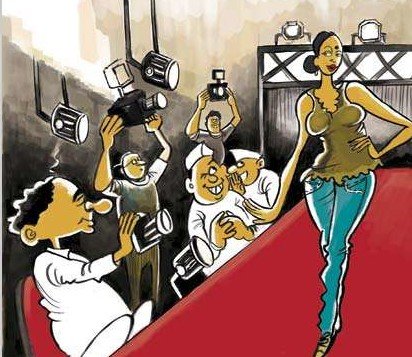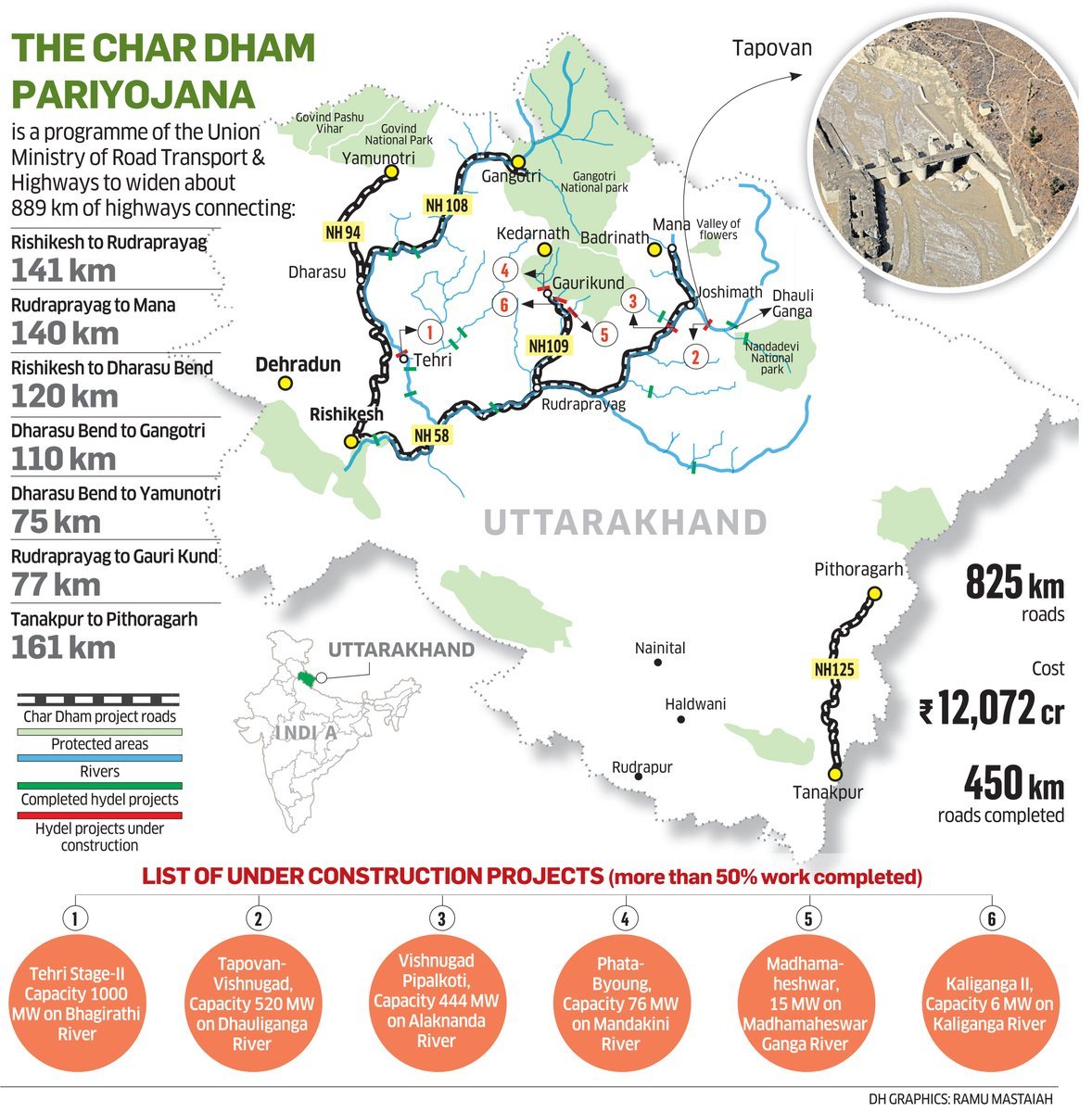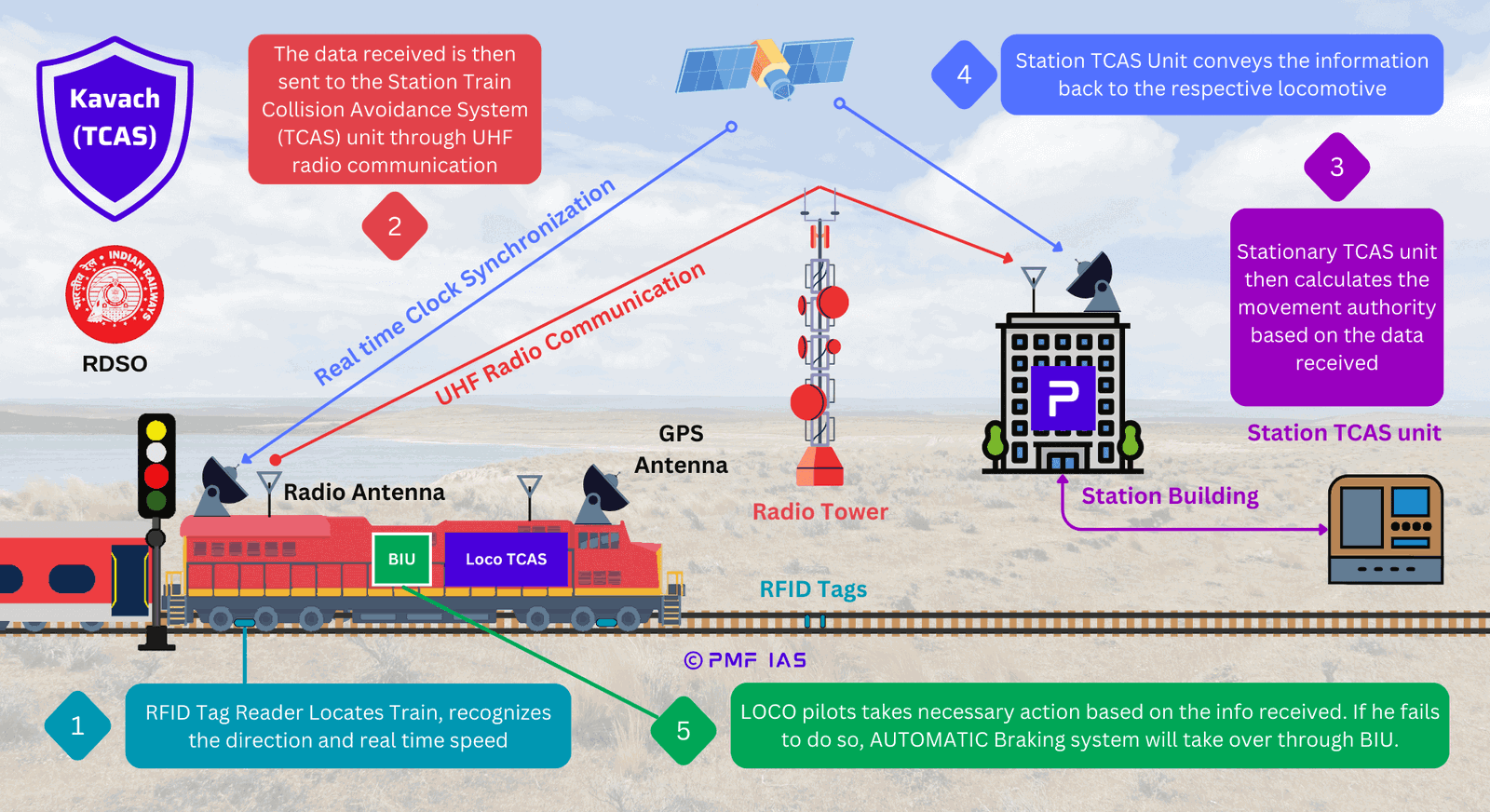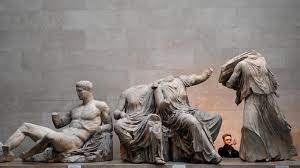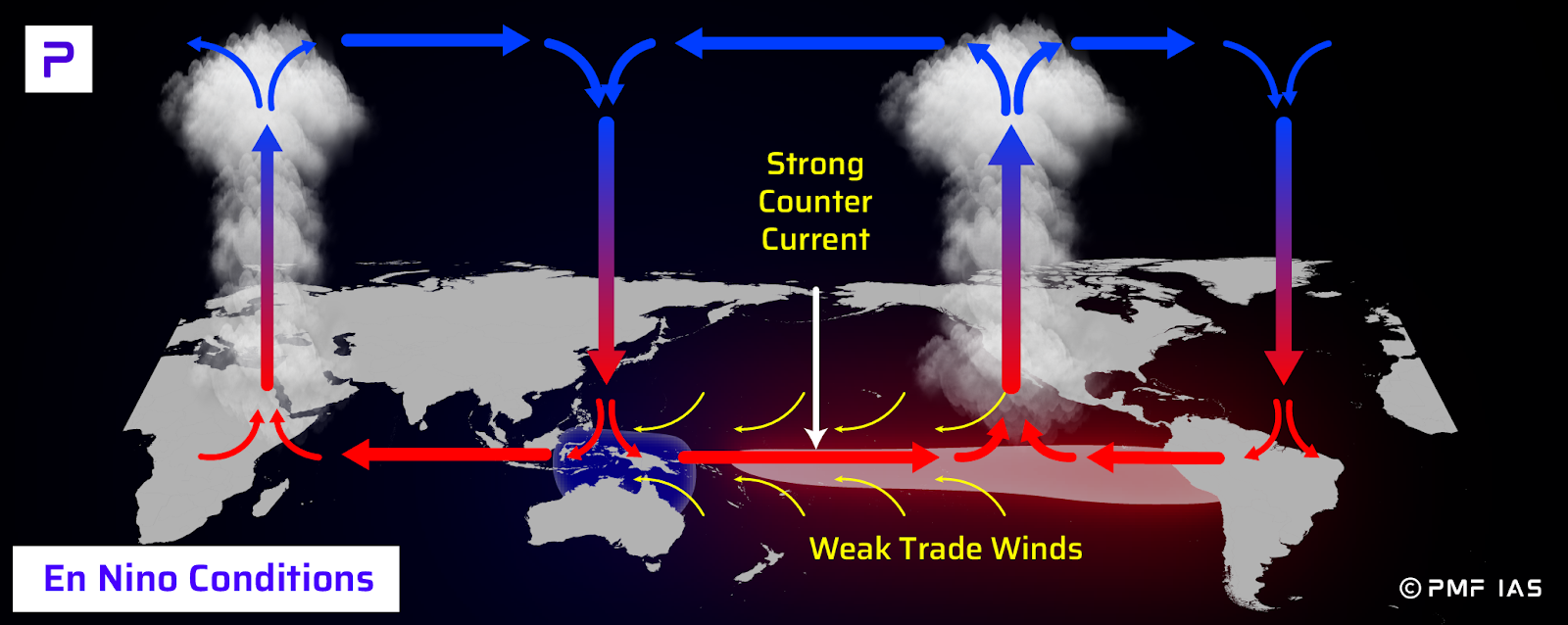
Current Affairs November 29, 2023: Cultural Property Agreement, Critical Minerals, Indian Ocean Tuna Commission, All India Judicial Services
Subscribers of "Current Affairs" course can Download Daily Current Affairs in PDF/DOC
Subscribe to Never Miss an Important Update! Assured Discounts on New Products!
Must Join PMF IAS Telegram Channel & PMF IAS History Telegram Channel
{GS1 – A&C – Art} Cultural Property Agreement
- Context (IE): India is close to signing the Cultural Property Agreement with the United States under the process for the return of stolen antiquities.
- The agreement is a tool to prevent the illicit trafficking of cultural artefacts.
- The agreement imposes import restrictions that stop looted and stolen cultural property from entering the US while encouraging the legal sharing of such objects for scientific, cultural, and educational purposes.
- It includes a Designated List of Archaeological Materials that is used for import restrictions.
- Objective: To protect cultural heritage and to reduce the incentive for further pillage of archaeological and ethnological material.
- These agreements are established under the 1970 UNESCO Convention on the Means of Prohibiting and Preventing the Illicit Import, Export, and Transfer of Ownership of Cultural Property.
|
How are Indian Origin Objects Repatriated?
- Currently, when an artifact of Indian origin is discovered in a foreign nation, the confirmation of its origin requires the submission of documents like First Information Reports (FIRs) and visual evidence.
- The validation process takes place in the host country, overseen by the Archaeological Survey of India (ASI).
- A group of ASI experts travels to the respective country to authenticate the objects, relying on their expertise, iconography assessment, and examination of wear-and-tear marks.
- However, there is no specified time frame for this verification process.
Significance of the Agreement
- Eliminate key sources of funding for terrorists and transnational organized crime.
- Prevent illegal trafficking of cultural property from India to the US.
Archaeological Survey of India (ASI)
|
{GS1 – Geo – Minerals} Critical Minerals
- Context (LiveMint): GoI will launch the 1st ever auction of Critical minerals in an attempt to boost the exploration and development of these minerals.
- A critical mineral is a metallic or non-metallic element crucial for modern technologies, economies, and national security, with the potential risk of disruptions to its supply chains.
- It includes both primary and processed minerals.
- Countries create their own critical minerals list based on strategic needs.
- Minerals such as nickel, titanium, vanadium, and tungsten are among the 30 critical minerals identified by India.
How does India identify Critical Minerals?
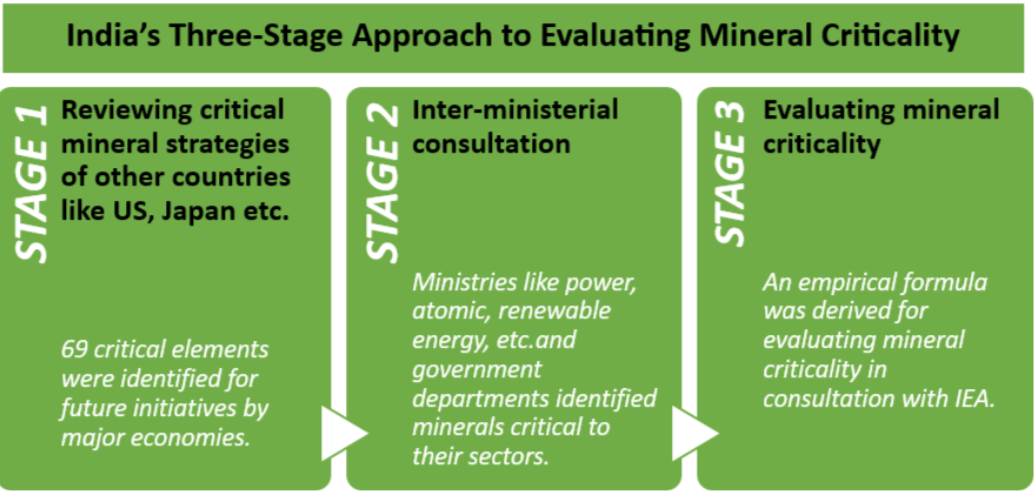 Key Drivers of Critical Minerals
Key Drivers of Critical Minerals

Production & Reserves
Lithium
- Australia is the world’s largest lithium producer, accounting for nearly half of global production in 2021.
- Bolivia, Chile and Argentina (the “lithium triangle”) have the largest estimated resources, with nearly 50 million tonnes of lithium between the three countries.
- Chile holds the world’s largest lithium reserves and is the world’s second-largest producer.
- Australia ranks second in the world for proven reserves.
- As per BloombergNEF, global lithium-ion battery demand for electric vehicles will reach 2,900 GWh by 2030.
- In India, lithium reserves are discovered in J&K, Rajasthan.
Cobalt
- Cobalt reserves are mainly in the Democratic Republic of Congo (51%) followed by Australia (17%).
- Besides, major reserves are also located in Cuba (7%), Philippines and Russia (4% each) and Canada 3%.
- In India, 69% of deposits are concentrated in Odisha and 31% in Jharkhand.
Rare earth elements (REEs)
- China has the highest reserves of REEs followed by Vietnam and Brazil.
- REEs available in India: Lanthanum, Cerium, Neodymium, Praseodymium and Samarium, etc.
Strategic Significance of Critical Minerals
- Economic implications: Integral to the manufacturing sector, especially in the production of EVs, renewable energy systems, and high-tech devices.
- National security and defense: It is essential for defense technologies, including weapon systems, communication equipment, and surveillance.
- Diplomatic Leverage by fostering partnerships and collaborations with mineral-producing nations. For eg, the India-Australia Critical Minerals Investment Partnership.
Challenges in Harnessing Critical Minerals
- Domestic supply constraints: low domestic reserve base, technical challenges in exploiting reserves economically, poor policies impacting their extraction.
- Infrastructure gaps: Insufficient infrastructure for mining, processing, and refining critical minerals poses a significant challenge leading to higher costs, delays, and environmental concerns.
- Dependence on imports:
- India imports 80 percent of its lithium and 85 percent of its cobalt from China.
- China is the world’s largest producer of 16 critical minerals, responsible for approx 60-70% of global production of cobalt and rare earth elements.
- Recycling and waste management: As per UNEP, less than 1% of the critical minerals used in electronic waste are recycled.
Way Forward
- Developing a national policy framework: Defining vision, objectives, priorities, and actions, and coordinating implementation across ministries and stakeholders. For eg. Creating a new list of such minerals in the MMDR Act.
- Enhancing exploration and production by leveraging geological potential, attracting private investment, and explore offshore and deep-sea mining for critical minerals.
- Strengthening international cooperation, diversify supply chains, promote responsible sourcing, and participate in global platforms. For eg, Mineral Security Cooperation between India, USA and Australia, being part of G7’s Sustainable Critical Minerals Alliance.
{GS1 – MIH – Personalities} Mahatma Jyotirao Phule
- Context (TH): Visakhapatnam Collector paid tribute to Mahatma Phule on his death anniversary.
- Jyotirao (Jotiba) Phule was born in 1827 in a low-caste Mali family.
- He was aware of the socially degraded position of non-Brahmins and untouchables in Maharashtra.
Caste Reforms
- He challenged caste discrimination and propagated equality.
- He proposed that Shudras (labouring castes) and Ati Shudras (untouchables) should unite to challenge caste discrimination.
- He founded an association called Satyashodhak Samaj in 1873 to propagate caste equality.
Women’s Education
- He was a pioneer of women’s education in Maharashtra.
- He started India’s first school for girls at Bhide Wada in Pune.
- He, along with Savitribai Phule and Fatima Sheikh, took charge of spreading education among the downtrodden communities.
Widow Remarriage
- He was also concerned about the plight of upper-caste women.
- He pioneered the widow remarriage movement in Maharashtra and opened a home for widows in 1854.
Books written by Jyotirao Phule
- Trutiya Ratna
- Powada: Chhatrapati Shivajiraje Bhosale Yancha Powada
- Powada: Vidyakhathatil Bramhan Pantoji
- Satsaar
- Brahmnanche Kasab
- Gulamgiri (Slavery): Phule dedicated his book to all those Americans who had fought in the American Civil War, which ended slavery in America.
- Shetkaryacha Asood
- Ishara
- Sarvajaneek Satyadharma
Fatima Sheikh
|
{GS2 – IR – India-Global South} Regional Conference on Access to Legal Aid
- Context (PIB): India hosted the 1st regional conference on Access to Legal Aid in New Delhi on November 27 and 28.
- It is a first-of-its-kind platform where the leaders of the two pillars of democracy, legislature and judiciary, come together to accelerate progress towards SDGs.
- It was organised by:
- National Legal Services Authority (NALSA)
- International Legal Foundation (ILF)
- United Nations Development Programme (UNDP)
- United Nations Children’s Fund (UNICEF).
|
Objective
- To give a platform to the participating countries of the Global South to facilitate the sharing of information and best practices for strengthening the delivery of legal aid services.
Participation
- The Conference involves participants from 69 Africa-Asia Pacific countries of the Global South and the host country, India.
- The conference brings together Chief Justices, Ministers of Justice, legal aid officers, policymakers, and civil society experts.
National Legal Services Authority of India (NALSA)
|
{GS2 – IR – India-Southeast Asia} AIGIF
- Context (PIB): The fourth edition of the ASEAN India Grassroots Innovation Forum (AIGIF) was launched in Langkawi, Malaysia.
- The AIGIF is an annual programme that fosters a strengthened relationship between India and ASEAN Member States (AMS) based on cooperation in Science, Technology, and Innovation (STI).
- The ASEAN-India Grassroots Innovation Forum is organised by:
- ASEAN Committee on Science, Technology, and Innovation (COSTI).
- National Innovation Foundation (NIF), India.
- Department of Science and Technology, GoI.
- Science and Technology Ministry of the host nation.
- The 1st forum was held in Indonesia in 2018.
- It aims to give exposure to social innovations and strengthen governance in the grassroots innovation ecosystem.
- It provides a platform for participants to share experiences and best practices in grassroots innovation among ASEAN and Indian communities.
{GS2 – IR – Multilateral} Indian Ocean Tuna Commission
- Context (PIB): The Department of Fisheries, GoI, is organising the 19th Working Party on Data Collection and Statistics (WPDCS19) of the Indian Ocean Tuna Commission (IOTC).
- The Indian Ocean Tuna Commission (IOTC) is an intergovernmental organisation responsible for managing tuna and tuna-like species in the Indian Ocean.
- It was established in 1993 by the Food and Agriculture Organization of the UN.
- It is mandated to manage highly migratory (tuna and tuna-like) fisheries resources sustainably in the Indian Ocean.
- Objective: To promote cooperation amongst contracting members to ensure the sustainable use of fishery resources.

Membership
- The IOTC currently has 31 contracting parties who are members of the IOTC and two cooperating non-contracting Parties, Liberia and Senegal.
- IOTC Members can make decisions concerning managing tuna and tuna-like resources and their associated environment binding on all Members and Cooperating non-contracting Parties.
- Membership of the IOTC is open to:
- Indian Ocean coastal countries.
- Countries or Regional economic integration organisations that are members of the UN.
- Countries that are members of UN special organisations.
- Countries that fish for tuna in the Indian Ocean.
Tuna
|
{GS2 – Polity – IC – Judiciary} All India Judicial Services (AIJS)
- Context (TH): The President of India recently called for the establishment of All India Judicial Services (AIJS) for recruiting Judges.
- Art. 312 of the IC provides for the creation of one or more All India Services common to the Union and the States.
- Such a service can be created and regulated by the Parliament by law, provided that the Council of States has declared by resolution, supported by not less than two-thirds of the members present and voting, that it is necessary or expedient in the national interest to do so.
- The Constitution (42nd Amendment) Act, 1976 inserted All-India Judicial Services (AIJS) under Art 312.
- The Amendment act says that the AIJS shall not include any post inferior to that of a district judge.
Argument in Favour of AIJS
- Improve efficiency and effectiveness of subordinate judiciary, thus, reducing pendency of cases at district/lower judiciary (3.8 cr cases).
- Attract the best legal talent, through a transparent all-India merit selection system, who could later become part of the higher judiciary.
- Fill vacancies faster and improve judge to population ratio. The Law Commission recommended a level of 50 judges per 10 lakh population, from the current 19 Judges/10 Lakh) [The lower judiciary is staring at >5,000 vacancies].
- Overcome the ills of nepotism and corruption. It would ensure that lawyers from the “marginalized” communities get due representation in the lower judiciary. For eg. OBC accounted for only 12% of judges in the lower judiciary.
Arguments Against AIJS
- Inadequate knowledge of the regional language would dampen judicial efficiency.
- Promotional opportunity of members of the State judiciary would be adversely affected.
- Erosion of control of the High Court over the subordinate judiciary, impairing judicial independence. Viewed as against Separation of Power, as judicial appointments made by the executive.
- Centre-State Conflict, where states view AIJS as against the principle of federalism, and an affront on states’ power to make appointments.
{GS2 – Polity – IC – Separation of Powers} Privileged Communication
- Context (LiveMint): The proposed Bharatiya Sakshya Bill which intends to replace the Indian Evidence Act, 1872 includes a provision that bars Court from inquiring into privileged communication between ministers and the President of India.
- Where Art 74 (2) of the IC provides that advice tendered by Ministers to the President shall not be inquired into in any court, the bill seeks to give it legal backing.
- However, the term Privileged Communication has not been defined leading to interpretation challenges.
- Privileged Communication refers to the confidential conversations or interactions between two parties who are in a legally recognized protected relationship.
- The information cannot be leaked to any third party, not even in the Court.
- It encourages open and honest communication within these relationships by assuring individuals that their confidential disclosures are legally protected.
When is the Privilege Lost?
- If the communication is made to further an illegal purpose.
- If the plaintiff himself waives his right.
- If the information is disclosed to a third party. In this case, a third party is a person who is not a part of the protected relationship.
For details on Bharatiya Sakshya Bill > PMF IAS August Monthly Compilation
{Prelims – Awards} Booker Prize 2023
- Context (IE): Irish author Paul Lynch’s “Prophet Song” was named the winner of the Booker Prize 2023.
- It is a literary award conferred annually for the best novel written in the English language.
- It is open to authors from the UK, Ireland, and the Commonwealth.
- The winners are awarded £50,000 prize money and a trophy.
- Indians who have been awarded the prize: V.S. Naipaul, Salman Rushdie, Arundhati Roy, Kiran Desai, and Aravind Adiga.
|
{Prelims – Events} Kambala
- Context (IE): Kambala is a traditional buffalo race in Karnataka.
- It is a folk sport practised in coastal districts where Tulu speakers are the majority.
- The race is part of a harvest festival held in muddy paddy fields after the harvest.
Banned by the SC
- Several organisations, including People for the Ethical Treatment of Animals (PETA), filed a petition against traditional sporting events, citing animal abuse.
- The argument against Kambala was that the buffaloes had their noses tied with a rope and were whipped continuously during the race, which was seen as cruel treatment.
- The SC heard these petitions and ruled to ban Jallikattu, Kambala and bullock cart racing in 2014.
How was the ban lifted?
- In 2016, an exception was made by the Environment Ministry, allowing bulls to be trained as performing animals for traditional events like Jallikattu and Bullock Cart Races in Maharashtra, Karnataka, Punjab, Haryana, Kerala, and Gujarat.
- At the same time, state governments amended provisions of the Prevention of Cruelty to Animals Act to provide an exemption for these events.
- A five-judge Constitutional Bench upheld the amendments made by Karnataka, Tamil Nadu, and Maharashtra.
Prevention of Cruelty to Animals Act 1960
Animal Welfare Board of India
|





![PMF IAS Environment for UPSC 2022-23 [paperback] PMF IAS [Nov 30, 2021]…](https://pmfias.b-cdn.net/wp-content/uploads/2024/04/pmfiasenvironmentforupsc2022-23paperbackpmfiasnov302021.jpg)
 Key Drivers of Critical Minerals
Key Drivers of Critical Minerals

